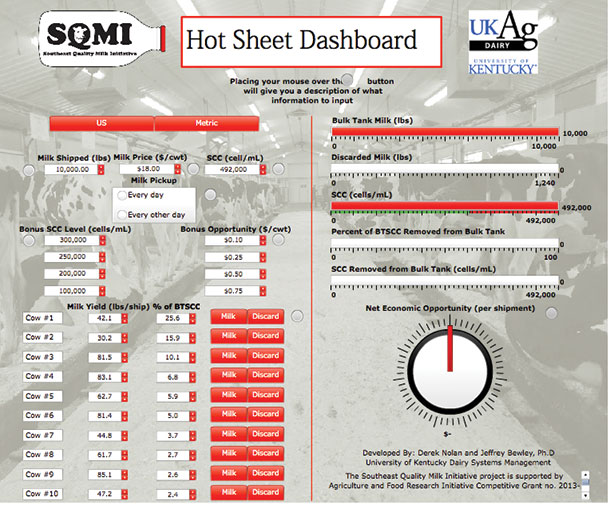The University of Kentucky and Southeast Quality Milk Initiative recently released a Hot Sheet Dashboard as part of their online decision tools offerings.
We asked the developers, University of Kentucky associate professor Jeffrey Bewley and graduate student Derek Nolan, to provide more information about the dashboard and its benefits to producers. The dashboard is available online .

What is the Hot Sheet Dashboard?
The UK/SQMI Hot Sheet Dashboard is a decision support tool developed for dairy producers to easily use information from their DHI Hot Sheet.

Why was it developed?
The Hot Sheet is one of the most useful pieces of information that dairy producers receive from DHI, but it can be complicated for producers to determine what to do with the information. The dashboard was developed as an educational tool to calculate the impact a cow or a group of cows may have on the bulk tank somatic cell count (SCC) – and then shows this impact with an economic value.

Why does the DHI Hot Sheet make it hard for producersto determine what to dowith the information it provides?
The Hot Sheet lists the cows that make up the top percent of the bulk tank SCC and what the bulk tank SCC would be without a certain cow and all of the cows listed above her. This is very beneficial, but there may be a better combination of cows to lower the bulk tank SCC than one cow or all of the cows above her.
The dashboard allows the producer to choose which cows they would like to discard from the tank to find the best combination for a lower SCC. It may also lead to other management decisions for a particular cow.

Who should use the dashboard?
The tool is better suited for a smaller dairy producer. As herd sizes increase, one cow or even a group of cows has a smaller impact on the bulk tank SCC.


Is there a cost to use it?
No, the dashboard is free to anyone with Internet access.

What are some unique features?
The tool is very easy to use and easily accessible. It allows producers to enter in their specific farm information straight from their DHI Hot Sheet. It is also functional with the metric system, so farmers all around the world can use it.

How does it work?
A producer starts by choosing the measurement system they use – U.S. or metric. After clicking either U.S. or metric, the measurement they have chosen will turn black. Using information from a milk check or a bulk tank record, producers fill in the milk weight that is shipped per pickup and the current milk price. This can be done by either typing the number in the box or clicking on the arrows to the right.
Next, using data from the Hot Sheet, a user will record the average weighted SCC at the top of the page and then choose whether their milk is picked up every day or every other day, by clicking the circles to the left.
With information provided from the milk processor, the next step is to enter the SCC levels that the processor will provide bonuses for.Then, in the column to the right, list the bonuses that are received with the corresponding SCC.
Again, these can be entered by typing the numbers or using the arrows to the right. Using the Hot Sheet, a user will enter in the milk yield for the test day and the percent of the bulk tank SCC of the top 10 cows on the Hot Sheet. Finally, a user will determine which cows to milk in the tank and which cows to discard. After clicking “Milk” or “Discard,” the option they have chosen will turn black.
On the right side of the dashboard, equations in a hidden spreadsheet calculate the amount of milk and SCC of the milk in the bulk tank after the cows chosen by the user have been removed from the tank.
It also calculates the amount of discarded milk, the percent of bulk tank SCC and the actual SCC that have been removed by discarding the milk from those cows. Once the SCC is under the highest SCC amount the user has determined they will receive a bonus, the bar will turn green, indicating their SCC is under the bonus level.
Finally, the net economic benefit is determined by taking the milk yield in the bulk tank multiplied by the sum of the milk price and the bonus level received for having a lower SCC.

Why is it important for producers to understand the economic benefit of how a cow (or group of cows) affects the bulk tank SCC?
Prevention methods are still the best way to manage and keep a low SCC. Dairy producers are business people and realize the value of a dollar. We hope that providing them with a tool to determine the money that can be made by lowering their SCC will not just lead to discarding a high-SCC cow or group of cows.
Instead, we hope the monetary value is an extra indicator for producers to determine the reason that cow or group of cows may have an elevated cell count and the management steps necessary to lower their SCC.

What feedback have you heard from dairy producers?
The dashboard has not been available long enough to receive feedback from producers using the tool, but it has been positively accepted at meetings and conferences where it has been presented. PD




